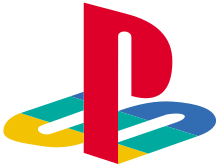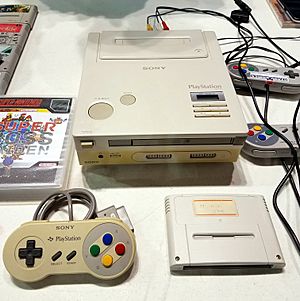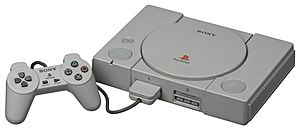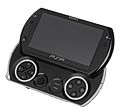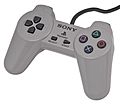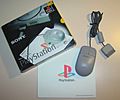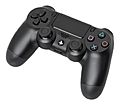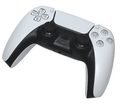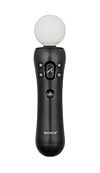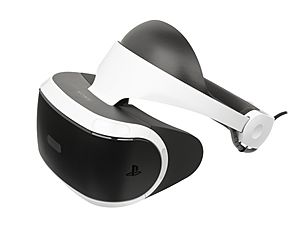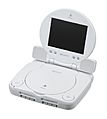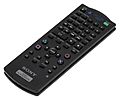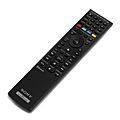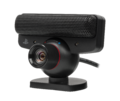PlayStation facts for kids
| Type |
|
|---|---|
| Owner | Sony Interactive Entertainment |
| Country | Minami-Aoyama, Minato, Tokyo, Japan |
| Introduced | December 3, 1994 |
| Markets | Worldwide |
| Tagline | "Play has no limits." |
PlayStation (Japanese: プレイステーション, Hepburn: Pureisutēshon, officially abbreviated as PS) is a super popular video gaming brand created by Sony Interactive Entertainment, a part of Sony. It includes many cool things like home video game consoles, handheld gaming devices, online services, and even magazines!
The very first PlayStation console came out in Japan in December 1994. It was a huge hit, selling over 100 million units in less than ten years! Its next version, the PlayStation 2, launched in 2000 and became the best-selling home console ever, with over 155 million units sold. Then came the PlayStation 3 in 2006, followed by the PlayStation 4 in 2013, which sold a million units in just one day! The newest console, the PlayStation 5, arrived in 2020 and quickly sold 10 million units, making it the fastest-selling PlayStation console so far. PlayStation consoles are famous for their DualShock controllers, which give you cool vibration feedback while you play.
Sony also made handheld consoles. The PlayStation Portable (PSP) sold 80 million units worldwide. Its successor, the PlayStation Vita (PSVita), came out in 2011. There's also the PlayStation TV, which is like a small, non-portable version of the PS Vita that connects to your TV.
The PlayStation Network is a huge online service with over 103 million active users every month. It has the PlayStation Store, where you can buy and download games and movies. There's also PlayStation Plus, a special membership that gives you extra benefits like free games and discounts.
The Story of PlayStation
How PlayStation Started
PlayStation was the brilliant idea of Ken Kutaragi, a Sony executive often called "The Father of the PlayStation." Before PlayStation, Sony mostly made parts for other game consoles, like the sound chip for Nintendo's Super Famicom.
Sony and Nintendo even worked together on a CD-ROM version of the Super Famicom, called "Play Station." But in 1991, Nintendo suddenly ended their partnership with Sony. This made Sony's President, Norio Ohga, very upset. He then told Kutaragi to create a new PlayStation project to compete with Nintendo.
Kutaragi showed Sony's leaders a new system that used CD-ROMs and amazing 3D graphics for games. Even though some older executives weren't sure about it, President Ohga decided to keep the project going. Kutaragi and his team moved to Sony Music to work on it.
At first, they weren't sure if the console should focus on 2D or 3D graphics. But after seeing how popular Sega's Virtua Fighter was in arcades with its 3D graphics, Sony knew that 3D was the way to go for PlayStation.
The PlayStation logo was designed by Manabu Sakamoto. He wanted it to show off the console's 3D power. He created an optical illusion with the letters "P" and "S" that looks like they have depth. He also used four bright colors: red, yellow, green, and blue.
Creating Sony Computer Entertainment
On November 16, 1993, Sony Computer Entertainment Inc. (SCEI) was formed. This new company, with help from Sony Music, was able to attract talented game creators and handle making and selling game discs.
In 1993, Phil Harrison joined SCEI to help get game developers to make games for the new PlayStation. In 1994, after showing off their plans and new console to game makers in Tokyo, many developers became interested. Companies like Electronic Arts and Namco became big partners. Developers liked that the PlayStation used CD-ROMs and 3D graphics, which was cheaper and easier to make games for than Nintendo's cartridge system.
The PlayStation launched in Japan in December 1994. It sold incredibly well because it was cheaper than its rival, the Sega Saturn. Soon, its popularity spread across North America and Europe.
PlayStation Home Consoles
The Original PlayStation (PS1)
The first PlayStation came out in Japan on December 3, 1994. It was a major part of the fifth generation of video game consoles, competing with the Sega Saturn and the Nintendo 64. By 2003, the PlayStation and its smaller version, the PS one, had sold over 102 million units combined. It was the first video game console to sell 120 million units!
PS One: A Smaller Design
Released on July 7, 2000, the PS One was a much smaller and redesigned version of the original PlayStation. It even outsold other consoles, including its successor, for the rest of that year! It had a new look and a slightly different menu screen.
PlayStation 2 (PS2)

The PlayStation 2 (PS2) launched in 2000. It was part of the sixth generation of video game consoles, competing with the Xbox and GameCube. The PS2 could also play most games from the original PlayStation. It's the most successful console ever, selling over 155 million units! It reached 100 million units faster than any other console before it. Production of the PS2 ended in 2012, but many people still own one.
PS2 Slimline: Thinner and Quieter
In 2004, Sony released the PlayStation 2 Slimline. It was smaller, thinner, and quieter than the original PS2. It also had a built-in internet port. Later versions of the Slimline became even lighter.
PlayStation 3 (PS3)

The PlayStation 3 (PS3) came out on November 11, 2006. It was a seventh generation console, competing with the Microsoft Xbox 360 and the Nintendo Wii. The PS3 was the first PlayStation to use motion-sensing technology with its Sixaxis wireless controller. It also had a Blu-ray Disc player and supported high-definition games. The PS3 sold over 80 million consoles worldwide.
PS3 Slim and Super Slim Models
Like its older brothers, the PlayStation 3 got a "slim" makeover in 2009. This new model was 33% smaller, 36% lighter, and used less power. It also had a better cooling system. In 2012, Sony released an even thinner "Super Slim" PS3. This version had a redesigned case with a sliding door for the disc drive, and it was almost three pounds lighter than the previous slim model.
PlayStation 4 (PS4)
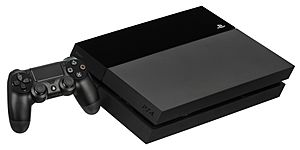
The PlayStation 4 (PS4) was announced on February 20, 2013. It brought a new type of computer architecture to PlayStation. Sony wanted to focus more on social gaming with the PS4. They added a "share" button on the new controller and made it easy to stream live gameplay to friends. The PlayStation 4 was first released in North America on November 15, 2013. It competed with Microsoft's Xbox One and Nintendo's Wii U and Switch.
PS4 Slim and Pro Models
The PlayStation 4 Slim came out on September 7, 2016. It was a smaller and lighter version of the original PS4, with a rounded, matte finish. It came with a slightly updated DualShock 4 controller.
The PlayStation 4 Pro (codenamed Neo) was also revealed on September 7, 2016. It was a more powerful version of the PS4, with a stronger graphics processor. It was designed to play games in 4K resolution and improve the experience for PlayStation VR. All PS4 games work on both the PS4 and PS4 Pro, but games optimized for the Pro look even better.
PlayStation 5 (PS5)
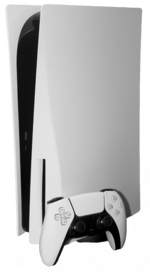
The PlayStation 5 (PS5) launched worldwide on November 12, 2020. It's part of the ninth generation of video game consoles, alongside the Xbox Series X and Series S. The PS5 has a super-fast custom SSD for quick loading times and amazing graphics, including ray-tracing for realistic lighting.
The new controller, called the DualSense, has special "adaptive triggers" that can change how they feel when you press them, like pulling back a bowstring in a game. It also has strong haptic feedback for more immersive vibrations. The PS5 can play most PlayStation 4 and PlayStation VR games, making it easy to switch to the new console.
PlayStation Handheld Systems
PlayStation Portable (PSP)
-
The original PlayStation Portable (PSP-1000)
-
PSP Go
(open position) -
PSP Street (PSP-E1000)
The PlayStation Portable (PSP) was Sony's first handheld console, released in 2004. It used a special disc called a Universal Media Disc (UMD) for games and movies. It had a similar button layout to the PlayStation consoles.
PSP-2000, PSP-3000, and PSP Go
Later, Sony released slimmer and lighter versions: the PSP-2000 (2007) and PSP-3000 (2008). These models were thinner, lighter, and had improved screens. The PSP-3000 even added a built-in microphone.
The PSP Go (2009) was a big redesign. It didn't have a UMD drive. Instead, it had 16 GB of built-in memory for games downloaded from the PlayStation Store. It was much smaller and lighter, with a screen that slid up to show the controls.
The PSP-E1000 (2011) was a budget-friendly PSP model. It didn't have Wi-Fi or stereo speakers, but it was more affordable.
PlayStation Vita (PS Vita)
The PlayStation Vita (PS Vita) was released in Japan in December 2011. It had a 5-inch OLED touchscreen, two analog sticks, a rear touchpad, and motion sensing. A lighter version, the PCH-2000 series, came out in 2013, with a longer battery life and an LCD screen. Sony stopped making the PS Vita in March 2019.
PlayStation Portal
The PlayStation Portal was released on November 15, 2023. It's a new portable device that lets you stream and play PS5 games from your home console.
PlayStation Controllers
Classic PlayStation Controllers
The first PlayStation controller came out in 1994. It had a basic design with a D-pad, four main buttons (Triangle, Circle, Cross, Square), and "shoulder buttons" (L1, L2, R1, R2). In 1997, the Dual Analog controller was released, adding two analog sticks for more precise control.
DualShock, Sixaxis, and DualSense
The DualShock controller, released in 1998, became the most famous PlayStation controller. It had two analog sticks and vibration feedback. The DualShock series includes the DualShock, DualShock 2 (for PS2), DualShock 3 (for PS3), and DualShock 4 (for PS4).
The Sixaxis was the first controller for the PlayStation 3. It was similar to the DualShock but didn't have vibration. All controllers from the Sixaxis onwards have a special 'PlayStation button' that lets you access system options.
PlayStation Move
PlayStation Move is a motion-sensing controller system for the PlayStation 3. It uses a special wand controller and the PlayStation Eye camera to track your movements, letting you play games with your body. It was launched in 2010.
Other Cool PlayStation Hardware
PocketStation
The PocketStation was a small device for the original PlayStation, released only in Japan in 1999. It was like a memory card combined with a tiny personal organizer. It had a black and white screen, a speaker, and could even communicate with other devices using infrared.
PSX (2003)
The Sony PSX, released in Japan in 2003, was a special device that combined a DVR with a PlayStation 2 console. It was the first Sony product to use the XrossMediaBar (XMB) menu system. You could even connect it to a PlayStation Portable to transfer videos and music.
PlayStation TVs and VR
Sony has also made televisions with PlayStation features built-in. The Sony BRAVIA KDL22PX300 (2010) was a TV that had a PlayStation 2 console inside! Later, a 24-inch PlayStation branded 3D television, the PlayStation 3D Display (2011), was released. It had a cool feature called SimulView, where two players could see their own full-screen view on the same TV using 3D glasses, instead of a split screen.
PlayStation VR is a virtual reality device made by Sony. It came out in October 2016. It has a special screen and uses 3D audio to make you feel like you're really inside the game world.
PlayStation Classic
The PlayStation Classic is a tiny version of the original 1994 PlayStation console. It was released on December 3, 2018, and comes with 20 classic games already loaded, plus two original-style controllers.
PlayStation Games
Each PlayStation console has tons of games! The PlayStation 2, PSX, and PlayStation 3 can even play most games from the original PlayStation. Some of these classic games can also be downloaded and played on the PlayStation Portable.
Games Made by PlayStation Studios
PlayStation Studios is a group of game developers owned by Sony. They make games especially for PlayStation consoles. They've created many famous game series like Gran Turismo, Uncharted, God of War, Ratchet & Clank, The Last of Us, and Spider-Man.
Re-released Games
Sony often re-releases popular games at a lower price under names like Greatest Hits (North America), Platinum Range (Europe), and The Best (Japan). These games have sold a lot of copies and been out for a while.
PS one Classics are original PlayStation games that you can download from the PlayStation Store for your PlayStation 3 or PSP. Classics HD are collections of PlayStation 2 games that have been updated with better graphics and new features for the PlayStation 3.
PlayStation Indies
Sony also supports indie game development. The PlayStation Indies program, started in 2020, helps new and exciting indie games get noticed on PlayStation 4 and 5.
PlayStation Online Services
PlayStation Network (PSN)
Released in 2006, the PlayStation Network is Sony's online service for playing games with friends and getting digital media. It's available on the PlayStation 3, PlayStation Portable, PlayStation Vita, PlayStation 4, and PlayStation 5. PSN has over 103 million active users every month! It offers features like PlayStation Home, the PlayStation Store, and Trophies.
PlayStation Store
The PlayStation Store is an online shop where you can buy and download games, add-on content, demos, themes, and trailers for your PlayStation consoles. It's updated every Tuesday with new content. You can use real money or PlayStation Network Cards to buy things.
PlayStation Plus
PlayStation Plus is a special membership service on the PlayStation Network. It gives you extra benefits like automatic game updates, early access to game demos, free downloadable games each month, discounts on the PlayStation Store, and more.
PlayStation App
The PlayStation App, released in 2011, is a free app for your phone or tablet. It lets you see your trophies, check which of your PSN friends are online, and read the latest PlayStation news.
PlayStation Now (Now part of PlayStation Plus)
PlayStation Now was a service that let you stream and play PlayStation 3 games on your PS3, PS4, PS5, PS Vita, PS TV, and even some Sony TVs. You could pay for access to a selection of games. In 2022, PlayStation Now became part of the PlayStation Plus service.
PlayStation Home (Closed)
PlayStation Home was a social gaming network for the PlayStation 3. It was like a virtual world where you could create an avatar, decorate your own apartment, explore public spaces, play mini-games, and meet other players. It closed in March 2015.
PlayStation Software Features
XrossMediaBar (XMB)
The XrossMediaBar (XMB) is a cool menu system used on the PlayStation 3 and PlayStation Portable, as well as other Sony devices. It has icons arranged horizontally across the screen. When you select an icon, more options appear vertically. You can even access parts of the XMB while playing a game on the PlayStation 3.
LiveArea
LiveArea is the special menu system designed for the PlayStation Vita. It's made for touchscreens and includes features that connect you with your friends through the PlayStation Network.
Linux Operating Systems (Older Consoles)
Linux for PlayStation 2
In 2002, Sony released a kit that let you install Linux on your PlayStation 2. This turned the console into a full computer system! You could connect a keyboard, mouse, and even go online.
Linux for PlayStation 3
The PlayStation 3 (except for the Slim model) also used to let you install Linux. This allowed users to do computer tasks on their console. However, Sony removed this feature in a software update in 2010.
Images for kids
See also
 In Spanish: PlayStation para niños
In Spanish: PlayStation para niños


